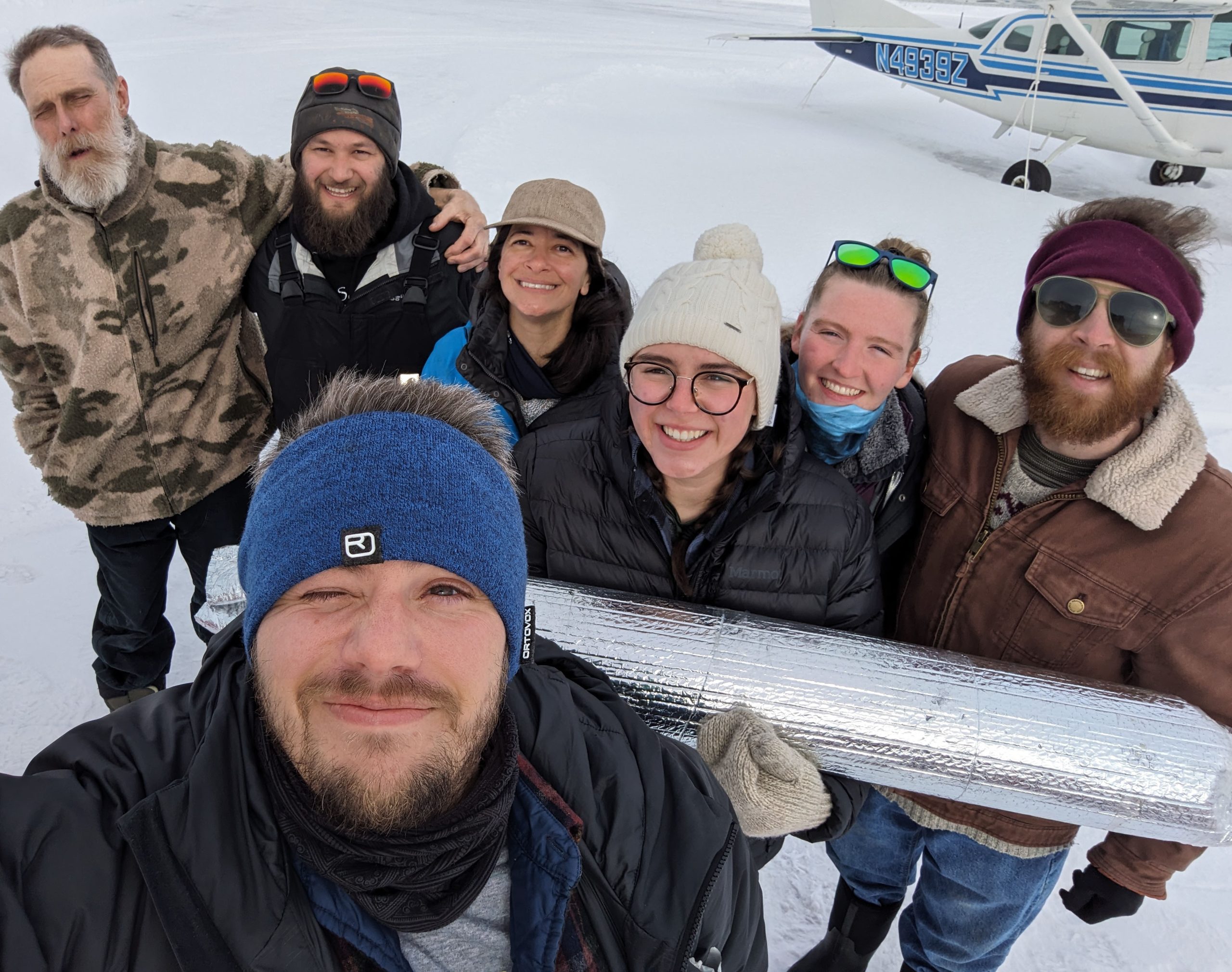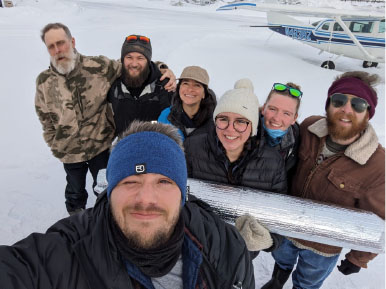
Understanding the Impacts of Pleistocene Megaherbivores on Ecosystem Stability in Alaska
Expedition Location: Kiana & Andy Lake, Alaska
Expedition Dates: March 31 – April 17, 2024
Field Team Members: *Alessandro Mereghetti1, Dr. Dulcinea V. Groff2, Joseph Boots-Ebenfield1, Kaitlyn Gerstler2, Shannon Thompson 1, Glenn Miller
1 University of Maine, Climate Change Institute 2 University of Wyoming
Funding Support: Dan & Betty Churchill Exploration Fund, NSF CAREER grant
Introduction:
One of the long-standing mysteries of Quaternary paleoecology is the disappearance of the mammoth steppe, a productive, patchy environment with elements of tundra, taiga and grassland that disappeared at the end of the Pleistocene. The post-glacial collapse of this pan-Arctic biome coincided with climate warming and the extinction of a diverse guild of Arctic megafauna, including woolly mammoths, horse, and steppe bison. Despite decades of research into this “Serengeti of the ice age,” outstanding questions remain about whether the widespread changes in vegetation were a cause, consequence, or independent of the megafaunal extinctions in the region (Zimov et al. 2012; Mann et al. 2015). Growing evidence from contemporary Arctic systems indicates that herbivores play an important role in mediating the impacts of climate change on vegetation resilience, suggesting that the late Quaternary extinctions may have had important consequences for Arctic resilience (Olofsson and Post 2018; Beer et al. 2020).
Andy Lake (Figure 1) is located in the Kotzebue Sound region of Alaska, close to the village of Kiana. Andy Lake was previously cored in 197

9, yielding an uninterrupted record of ~14 m (Anderson 1985; Berger and Anderson 2000) that did not reach bedrock or glacial till, suggesting that the sediment could go even deeper (Anderson, pers. comm.). This suggests that Andy Lake potentially holds the oldest paleoecological lake sedimentary record in Alaska, providing an ideal opportunity to investigate the relationship between the resilience of Arctic and megaherbivores. So far, addressing questions related to megafaunal disappearance and vegetation change using sediment was complicated by the coarse taxonomic resolution provided by available proxies. New advances in sedimentary ancient DNA (sedaDNA) provide the opportunity to improve our paleoecological reconstructions of Arctic environments with unprecedented taxonomic accuracy (Murchie et al. 2020), allowing us to investigate how the different parts of the system were interacting over time.
In April 2024 an expedition from the Climate Change Institute went to Kiana in an effort to 1) collect a sediment core from Andy Lake to be analyzed for sedaDNA, and 2) furthering our established collaboration with the School of Kiana (Northwestern Arctic Borough School District) and the Tribe of Kiana.
Results & Significance:
Over the 15 days of our stay in Kiana, the weather allowed us to work on the Lake for a total of 3 days. This allowed us to recover ~3 meters of sediment, which should cover the last ~25,000 years (a period that fully includes the deglaciation period and the collapse of the mammoth steppe). These sediments will be processed during June-July 2024 at the University of California Santa Cruz to determine their ancient DNA content and build a chronology of plant and animal population dynamics, while subsamples will be sent to our collaborators at the University of Wyoming for paleoclimate analysis. During days of bad weather for coring, we spent time interacting with the community of Kiana and the school personnel.



With the collaboration of the local teacher and the school principal, we visited the school to organize interactive activities with the 9th grade students. We involved them in practical activities aimed both at understanding the long-term process leading to the preservation of paleoecological information in lake sediments and at experimenting some techniques that mirrors those that we use in our labs (pollen processing and identification). These interactions developed in a plan to keep the students engaged with the prosecution of the work on the core with monthly virtual meeting on the progression of the project. During our stay in Kiana, we also furthered our connection with the Tribe, taking part in the monthly Tribal Council to report on the state of our project and establishing a protocol for effective communication and dissemination of the progresses and results of our work.
Acknowledgements:
This project was possible thanks to the Dan and Betty Churchill Exploration Fund and the NSF CAREER Program.
Bibliography:
Anderson, Patricia M. 1985. “Late Quaternary Vegetational Change in the Kotzebue Sound Area, Northwestern Alaska.” Quaternary Research 24 (3): 307–21. https://doi.org/10.1016/0033-5894(85)90053-5.
Beer, Christian, Nikita Zimov, Johan Olofsson, Philipp Porada, and Sergey Zimov. 2020. “Protection of Permafrost Soils from Thawing by Increasing Herbivore Density.” Scientific Reports 10 (1): 4170. https://doi.org/10.1038/s41598-020-60938-y.
Berger, G. W., and P. M. Anderson. 2000. “Extending the Geochronometry of Arctic Lake Cores beyond the Radiocarbon Limit by Using Thermoluminescence.” Journal of Geophysical Research: Atmospheres 105 (D12): 15439–55. https://doi.org/10.1029/2000JD900018.
Mann, Daniel H., Pamela Groves, Richard E. Reanier, Benjamin V. Gaglioti, Michael L. Kunz, and Beth Shapiro. 2015. “Life and Extinction of Megafauna in the Ice-Age Arctic.” Proceedings of the National Academy of Sciences 112 (46): 14301–6. https://doi.org/10.1073/pnas.1516573112.
Murchie, Tyler J., Melanie Kuch, Ana T. Duggan, Marissa L. Ledger, Kévin Roche, Jennifer Klunk, Emil Karpinski, et al. 2020. “Optimizing Extraction and Targeted Capture of Ancient Environmental DNA for Reconstructing Past Environments Using the PalaeoChip Arctic-1.0 Bait-Set.” Quaternary Research, September, 1–24. https://doi.org/10.1017/qua.2020.59.
Olofsson, Johan, and Eric Post. 2018. “Effects of Large Herbivores on Tundra Vegetation in a Changing Climate, and Implications for Rewilding.” Philosophical Transactions of the Royal Society B: Biological Sciences 373 (1761): 20170437. https://doi.org/10.1098/rstb.2017.0437.
Zimov, S.A., N.S. Zimov, A.N. Tikhonov, and F.S. Chapin. 2012. “Mammoth Steppe: A High-Productivity Phenomenon.” Quaternary Science Reviews 57 (December):26–45. https://doi.org/10.1016/j.quascirev.2012.10.005.

